PinotFile: 7.1 August 19, 2008
|
The Long and Winding Pinot Road, Part XIVMy forty year love affair with Pinot Noir has been detailed in the previous thirteen chapters of the novella, “The Long and Winding Pinot Road,” published in several issues of the PinotFile over the past several months. I now have even greater passion for Pinot Noir than in April, 2001, when I started the PinotFile newsletter to spread my enthusiasm. To read the story in its entirety, go to page 15. With this issue, I am proud to present a new look to the PinotFile and the launch of my new Prince of Pinot website at www.princeofpinot.com. It is remarkable to think about the changes in the world of Pinot Noir over the last seven years since the PinotFile began. The internet has become a powerful medium for sending out to the world the compelling stories behind every good bottle of Pinot Noir. The movie ‘Sideways’ brought Pinot Noir into everyone’s consciousness and the movie’s most famous lines found a place in everyone’s heart. The thin and insipid Pinot Noirs of Oregon and California’s past became a distant memory. Steve Pitcher’s remarks in The Wine News in May, 2002 ring out even more true today: “Of all the accomplishments in American winemaking and viticulture in the last quarter of the 20th century, none has been as impressive as the dramatic evolution of Pinot Noir from near-dismal failure to celebrated success poised at the threshold of greatness.”
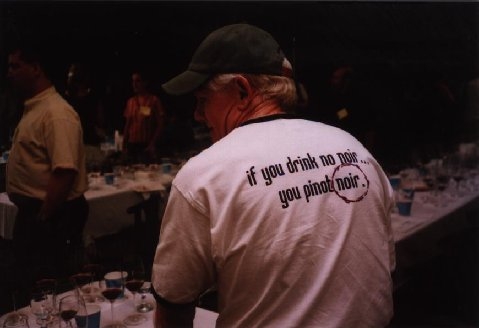 The PinotFile’s original mission statement, “To keep readers apprised of news in the pinotphile world including latest releases, winery news, winemaker profiles, what to buy, and how to get your hands on it,” continues to this day. For a number of reasons, it has become challenging to fulfill this mission. There are more producers of Pinot Noir and more quality Pinot Noir in the world than ever before. In just Volume 6 of the PinotFile, wine reviews appeared from over five hundred wineries. New producers in California and Oregon are cropping up almost weekly. Reflecting the huge demand for Pinot Noir, prices of Pinot Noir have significantly increased making it far more expensive now to be an independent wine critic (I buy over 85% of the wines I review). Extensive traveling is obligatory to bring the inside stories behind the wines to the reader. In addition, I attend every major Pinot Noir event in California and Oregon to keep on top of the Pinot buzz. Fortunately, the financial rewards of my previous career as an ophthalmologist have allowed me to pursue my wine writing in a completely independent manner. I accept no press junkets to wineries or regions, avoid all forms of advertising in the newsletter and on the website, pay for nearly all events and meals, and have no financial interest in any wine business, winery or distributor. The PinotFile has always been offered free to subscribers. It has been a noble and thoroughly redeeming elevage, but frankly, to improve and expand the coverage of Pinot Noir in the PinotFile, it is necessary to begin charging a modest fee for the newsletter. There are many benefits to subscribing to the new PinotFile:
Bonus Online Content:
• PinotFile Live! Each issue of the PinotFile is highlighted in a 30 minute downloadable MP3 formatted podcast spiced with information not included in the PinotFile newsletter. Some podcasts feature noted wine personalities.
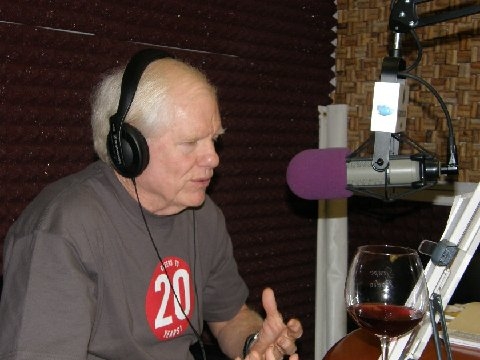 • Podcast interviews with winemakers, winegrowers and other Pinot personalities. • Links to all videocasts and podcasts in which the Prince participates on Grape Radio • Videos featuring Pinot people, many of which you have read about and heard about by reputation, but never seen “live.” • Pinot Winery Directory. Over 500 producers of Pinot Noir including background and descriptive information, vineyards, grape sources, owners, winemakers, viticulturists, tasting and tour arrangements, contact information, and MOST important, how can you buy the wine! The directory is a work in progress that will be growing as information from back issues are added and new producers profiled. I estimate that eventually there will be over 1,000 wineries profiled. • Vineyard Information. The most prominent vineyards will be fully detailed eventually with information on history, acreage, year(s) planted, clones, soil type, aspect, appellation, owners, and client wineries. • Travel Along the Pinot Trail. The Prince’s favorite wineries to visit and wine country lodging and restaurant recommendations organized by region. Google maps will soon be added. This is invaluable information for your next wine country trip and specific regions can be printed out for handy reference on your trip. The Prince will also assist subscribers in planning wine region trips and arrange for private tours and tastings. p> • Calender of all Pinot Festivals and other events of note where Pinot Noir is poured. • Links to all things Pinot. • Extensive Search Feature. Readers can search for specific tasting notes according to newsletter, winery, appellation or vineyard. Each tasting note now includes the date that the wine was sampled. In addition, there is a full Google search on the site. • Comments/Feedback. Readers can offer their commentary and corrections. • RSS Feed. Stay tuned to all updates on the site including News Flashes and timely links. The Prince of Pinot website is still a work in progress. It has taken me, my son Dane, and my two dedicated and patient website whizzes, Peter Rowell (www.techbuddy.us) and Wendy Coy (www.coydesign.com), over a year (about one vintage) to bring this innovative web site to fruition. Over the coming months, the site will undergo continued revision and evolution, much like a young Pinot Noir. Back issues will still be available to read and download, but all the information from back issues will not be in the searchable database until it is a gradually entered over the coming months.
 I will be introducing something new in the PinotFile in the tasting notes. I am firmly against wine scores, even though wineries, retailers and consumers grovel over them. Even noted wine critics Steve Tanzer and Allen Meadows have “admitted to misgivings about the 100-point system, but said they had no choice but to use it if they hoped to keep and augment their respective audiences” (Mike Steinberger, ‘Everyone A Critic. The Future of Wine Writing,’ The World of Fine Wine, 09/08). In the past, I have often chose to omit a review of a Pinot Noir if I could not recommend it. I will no longer do this as I believe it is just as important to emphasize wines of great merit as to point out wines that do not warrant recommendation. In addition, I am happy to introduce you to the PinotGeek, a mythical character of some repute who will preside over the best Pinot Noirs. Previously, many readers were able to “read between the lines,” and discover those Pinot Noirs that really turned me on. Now it will be obvious as the PinotGeek will appear in tasting notes signifying wines that are truly exceptional and worthy of your full attention. As the French would say (who know something about Pinot Noir), C’est top! (It’s the best!). The PinotGeek ‘s teeth are stained purple from dedicated tasting of Pinot Noir.
 The new Prince of Pinot website at www.princeofpinot.com will launch on September 5, 2008. On that date you will be able to visit and explore the site and subscribe to the PinotFile. A yearly subscription (26 issues) is $120. The new website will remain open to all visitors for 30 days, after which it will be available exclusively to paid subscribers. The PinotFile newsletter will no longer be e-mailed to subscribers. A notice will be sent to all subscribers when a new issue is posted on the website. Full access of the current and past issues will be available to subscribers using a name and password and any issue of the PinotFile may be downloaded and printed. No print form of the newsletter is available except through the web site. If you have any suggestions on how the web site can be improved, do not hesitate to contact the Prince through the Comments/Feedback section of the web site. Much credit and heartfelt thanks go to those who have supplied me with the necessary expertise and support to write the PinotFile over the last seven years: Steve Muller who designed my first website and my logo, David Isaacs who managed my website with dedication and a smile, Rene Chazottes who encouraged me and taught me integrity, my wife Patti who somehow had the patience to put up with my wacky devotion to a grape, and my mother who always said I would become a doctor or a writer (bless her heart, she was wrong, I became both)
The Prince’s StyleSince genetically we all possess disparate palates and therefore taste wines differently, the wines reviewed and recommended in the PinotFile are only a starting point for your own exploration of Pinot Noir. Like any wine critic, I do have my biases and my preferred style. However, I can appreciate all styles of Pinot Noir and I welcome diversity. I like to use the analogy of a suit maker. You may engage a suit maker to craft a fine suit for your personal configuration. When finished, the suit may not fit perfectly, but if the suit is very well made and the craftsmanship is evident, one can still admire it. Similarly with wine, a Pinot Noir may not conform to your personal stylistic taste, but you can admire the winemaking skill reflected in the finished product. It is senseless to disparage wines you personally do not like. You may like peas while others hate them. I disdain blue cheese and my wife adores it. I want to lead you on the path of discovery, but not do the discovery for you. You must explore, experiment, and find out what is magical for you. Mine is but one opinion, admittedly based on extensive experience, but not infallible or almighty! A Prince I might be, but I do not rule the world of Pinot Noir. Explore the kingdom and revel in the diversity. Finding good Pinot Noir today is not a difficult task. Consistency and excellence has never been better. Falling in love with Pinot Noir is easy to do, but as Cathleen Francisco has pointed out, “a tempestuous love affair it will be.” Pinot Noir changes in the glass from minute to minute. It is a chameleon, altering its aromas and flavors in the bottle from day to day, week to week. It can be showy one day, shy and withdrawn the next and is never the same. You must be a patient suitor able to welcome all the faces of Pinot Noir. The best advice I can give you is to get to know the producers and winemakers and develop a bond. Establish a loyalty for and an insight into the wine you are drinking and you will amplify your drinking experience. Don’t expect the same wine every vintage and relish in the spirit and character each year brings. Remember, it is the same composer, but never the same song. Most of you who read the PinotFile regularly will not find the following information a surprise. Here is my personal stylistic preferences in Pinot Noir: I look first for balance. Alcohol, acid, tannins and fruit all in harmony. I prefer complex aromas with no alcohol intrusion and complimentary oak. I delight in lively acidity. I am seduced by soft, velvety textures. I am impressed by wines that gain power and interest in the glass over time I like wines that show well the next day from an opened bottle indicating they will age very well. I prefer wines that are food-friendly. I like refreshing and juicy wines that make you want to take another sip. I prefer wines that are around 13.5%-14.0% in alcohol - I can drink more without getting sideways and these wines stand more on the grape than on the sweetness of alcohol. I find lighter-colored wines are more to my fancy. I prefer elegance and finesse, the calling card of fine Pinot Noir. Wines that are lacy and delicate, but hit you like a revelation. Sexy but in a slightly rough and erotic way. I really like wines that leave you searching for words. As winemaker Veronique Drouhin stated so eloquently: “There are lots of good wines in the world that give you pleasure. A great wine gives you emotion.” I usually taste wines in flights of six to eight in the morning when my palate is fresh in a quiet and peaceful setting. I use Riedel Vinum Burgundy glasses or Riedel Oregon Pinot Noir glasses only. The wines are opened at cellar temperature (55 to 60 degrees). I do several passes through the wines over 90 minutes, spitting along the way. I then swallow some of each wine. If the wine still seems closed, I will resample it in the evening or re-cork it and taste it the next day. I often re-taste the better wines with food at lunch or dinner. I will taste a second bottle if there is a question about the integrity of the bottle opened (if a second bottle is available). I do not taste blind, relying on my personal integrity to honestly report my findings. My wife (pictured below at last year’s harvest) often adds her opinion as well. As you know, women have great palates.
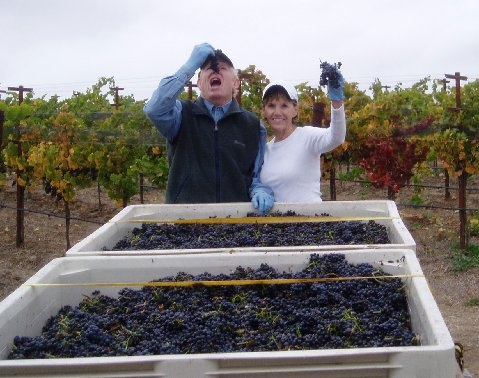
Olympics of Cult Pinot Collectibles
To commemorate my new web site launch and in the spirit of the Olympics, a few friends joined me recently
and we blind tasted a baker’s dozen of cult California and Oregon Pinot Noirs from recent vintages. These
wines have been subject to many disparaging titles such as “monuments to elitism,” and “toys for millionaires,”
but they remain of great interest to Pinot Noir lovers. Impossible to find, absurdly priced on the secondary
market, and more often sold on the auction market than consumed, they still remain the standard against which
other Pinot Noirs are measured. Many will scoff at tasting these wines in a comparative and competitive
setting, but it is the Olympic way.
2005 Aubert Reuling Vineyard Sonoma Coast Pinot Noir 2004 J. Rochioli West Block Russian River Valley Pinot Noir 2004 Kistler Cuvee Catherine Occidental Station Vineyard Sonoma Coast Pinot Noir 2005 Kosta Browne Kanzler Vineyard Russian River Valley Pinot Noir 2003 Marcassin Blue Slide Ridge Vineyard Sonoma Coast Pinot Noir 2005 Pisoni Estate Santa Lucia Highlands Pinot Noir 2005 Ponzi Abetina Vineyard Willamette Valley Pinot Noir 2004 Privé Vineyard Joie de Vivre Willamette Valley Pinot Noir 2006 Rivers-Marie Occidental Ridge Vineyard Sonoma Coast Pinot Noir 2005 ROCO Private Stash Willamette Valley Pinot Noir 2002 Sea Smoke Ten Sta. Rita Hills Pinot Noir 2004 Sine Qua Non Covert Fingers Sta. Rita Hills Pinot Noir 2002 Sine Qua Non Hollern’ M Shea Vineyard Willamette Valley Pinot Noir All the wines are well-crafted. Shy and delicate they are not. Several are quite high in alcohol. Generally, they strut highly concentrated fruit with dark fruit aromas and flavors predominating. They are well-muscled, strikingly sculpted, and truly Olympian in stature. It is easy to understand how these wines would score well in tasting panels for their flashiness can easily seduce. The Gold Medal was awarded to the 2005 Ponzi Abetina Vineyard Willamette Valley Pinot Noir which only barely edged out the 2004 J. Rochioli West Block Russian River Valley Pinot Noir, the 2005 ROCO Private Stash Willamette Valley Pinot Noir, and the 2002 Sine Qua Non Hollern’M Shea Vineyard Willamette Valley Pinot Noir. Prices are release prices from the winery except where otherwise noted. Aubert Mark Aubert has a distinguished winemaking career including ten years at Peter Michael. He grew up in the Napa Valley where he was more likely to drink wine and Champagne than beer. His father was a pharmacist who made Petite Sirah and Cabernet on the side. Mark graduated from Fresno State with a degree in enology and minors in chemistry and viticulture. He began his life as a winemaker at Monticello where he made that winery’s first lees-stirred Chardonnay. He struck up a friendship with Helen Turley who was consulting for Peter Michael. When the assistant winemaker at Peter Michael departed, Helen hired Mark. In 2000, Mark left Peter Michael to become the winemaker for Colgin, again replacing Helen Turley. At the same time, he started his own label, Aubert Wines. He bought a 7-acre Chardonnay vineyard in the Vine Hill area near Forestville (renamed Lauren Vineyard) and nearby planted another 6 acres of Chardonnay and 1.5 acres of Pinot Noir (Reuling Vineyard). The budwood for the Reuling Vineyard is from a famous source in Vosne-Romanee. He currently has four vineyard-designated Chardonnays (Ritchie Vineyard, Quarry Vineyard, Reuling Vineyard, Lauren Vineyard) and two Pinot Noirs (Reuling Vineyard and UV Vineyard), all in the Sonoma Coast appellation. Mark is a true gargariste and his tasting room is an unpretentious metal shed. He has a love for Burgundy and is a fan of Dujac, Jayer, Leroy and Meo-Camuzet (who isn’t?). His initial Pinot Noir releases were the 2004 Reuling Vineyard Sonoma Coast Pinot Noir (100 cases - 4 barrels) and the 2004 UV Vineyard Sonoma Coast Pinot Noir (also made in very small quantities). These wines are sold by invitation through a mailing list (www.aubertwines.com, 707-963-4569). Mark’s wife, Teresa, handles the business side of the label.
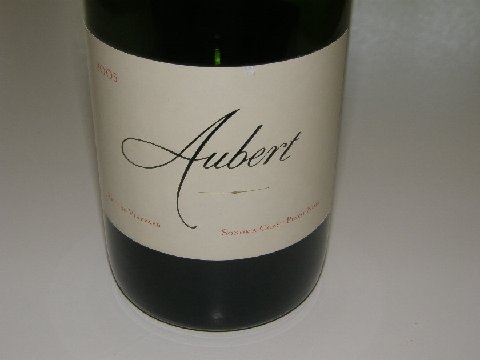 2005 Aubert Reuling Vineyard Sonoma Coast Pinot Noir 15.6% alc., $80. · The nose offers strong aromas of black fruits, oak and chocolate with a little alcohol peeking out in the glass over time. A massive wine composed of concentrated and mouth-coating flavors of plum reduction sauce, blackberry jam, cola and sassafras. Syrupy and smooth in texture with a long, opulent finish. Generous and fruity rather than classy or complex. May be too over-the-top for some.
J. Rochioli Vineyards & Winery The colorful Rochioli story as told to me by Joe Rochioli is detailed in depth in Volume 4, Issue 42 of the PinotFile. The first viable Pinot Noir crop from the Rochioli ranch was in 1971. In 1976 Joe made 1,000 cases of Pinot Noir and Chardonnay at Davis Bynum under the Fenton Acres label. In 1979 he sold some West Block Pinot Noir to Williams Selyem who made it famous (since 1998, Williams Selyem has received Pinot Noir from River Block only). Gary Farrell, the winemaker at Davis Bynum, made 50 cases of Rochioli Pinot Noir from West Block and Allen Vineyard which launched his Gary Farrell label. Also, in 1982 he made 150 cases of Pinot Noir for Rochioli to start the Rochioli brand. Shortly after this, Joe’s son, Tom, returned from the business world, disenchanted with his job and joined the farm. He used his business acumen to build a 10,000 case winery which was constructed on the estate in 1985. The name was changed to J. Rochioli Winery. A winemaker was hired, but after the first year, Tom took over and has made the wines ever since. Tom is a selftaught winemaker who never took any formal schooling in winemaking. Joe lives on the property in a house on the hill above the estate which he built by himself over a two year period. The plantings are divided into blocks and block-designated Pinot Noirs are produced along with an appellation wine.The appellation Pinot Noir is labeled Rochioli and the block-designates are labeled J. Rochioli. The blocks include West and East, Riverblock, Three Corner, Little Hill, and the newest plantings, Sweetwater. The Ranch now consists of 162 acres, of which 128 are planted to vines, 64 acres to Pinot Noir. The East and West Blocks began showing markedly diminished quantity and quality by 2006 due to various viruses and other diseases. These two blocks are gradually being replanted with West Block selection using modern trellising, rootstock and spacing. The single-vineyard and block-designated wines are sold through a mailing list ("The List"). The Rochioli Russian River Valley Pinot Noir, some of the Chardonnays, and the Sauvignon Blanc are also sold through the tasting room with some retail and restaurant distribution. The tasting room at 6192 Westside Road is a popular spot for tourists and is open Thursday through Monday. Total production is 13,000 cases of the three varietals. 707-433-2358. The website is www.rochioliwinery.com.
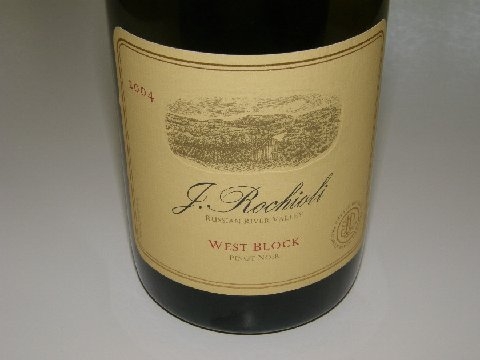 2004 J. Rochioli West Block Russian River Valley Pinot Noir 14.2% alc., 400 cases, $75. · Sweet-scented smell of spiced black cherries and strawberries that draws you deeply into the glass. Ripe, juicy, and vivid earth-tinged black cherry fruit with great richness and persistence. A wine that is delicious and seductive. The impeccable balance and refreshing acidity will keep this wine on course for many years.
Kistler Is there another winery in California that is been so successful without any marketing whatsoever, no public relations to speak of, no pubic tastings, no tasting room, absolutely nothing to suggest the owners have any interest in their consumer base? Robert Parker, Jr., is one of the privileged few to be able to taste Kistler's wines and anoints them as royalty. That is not to say the wines are not worthy. The Chardonnays go through 100% MLF and come out the other side very buttery and appealing although their greatest attribute is as a sipping wine and not primarily a food-friendly wine. The Pinot Noirs early on were highly extracted and heavily oaked, appealing to Parker's palate, but off-putting to many others especially considering the high prices that were demanded. The winemaking style for the Pinot Noirs has mellowed in recent years to the benefit of the wines. Not much is revealed publicly about the winery but production is around 25,000 cases of Pinot Noir and Chardonnay annually. Almost all the wine is sold through a mailing list in which wine is allocated on the basis of years of customer loyalty and volume of customer purchases. The list is almost ruthless in that those who do not buy significant quantities regularly soon suffer the consequences with scrawny allowances (a so-called “hostage winery”). These are wines for only the well-to-do as prices start at $70 a bottle and go up significantly from there. The winery was founded in 1978 and the first several years were rocky with some serious winemaking problems. Since then, success has come quickly and today all the wine is quickly snapped up. The proprietors are Steve Kistler and Mark Bixler. Steve Kistler received a B.A. from Stanford University, studied at University California Davis and Fresno State University for two years, and was an assistant at Ridge Vineyards for two years before founding Kistler Vineyards. He serves as winemaker and oversees vineyard operations. Mark Bixler received degrees from M.I.T. and University California Berkeley, taught Chemistry at Fresno State University for seven years, and worked at Fetzer Vineyards for two years. Mark shares winemaking responsibilities, and is the chemist and business manager for Kistler Vineyards. The grape sources include some of the finest vineyards in Napa and Sonoma Counties. After years of planning, a new winery was built at the Kistler's Vine Hill Vineyard in the Russian River Valley in 1992. The facility is thoroughly modern, optimized for the production of limited quantities of the very highest quality Chardonnay and Pinot Noir. The wines are only sold through a mailing list and the secondary market (which is extensive indicating many buyers buy, but do not drink the wines, opting instead to sell them for a handsome profit). Minimum purchase for each twice-yearly offering is a case. The Pinot Noirs come from Kistler Vineyard in the Russian River Valley, and Occidental Station and Bodega Headlands on the Sonoma Coast. The website is www.kistlerwine.com.
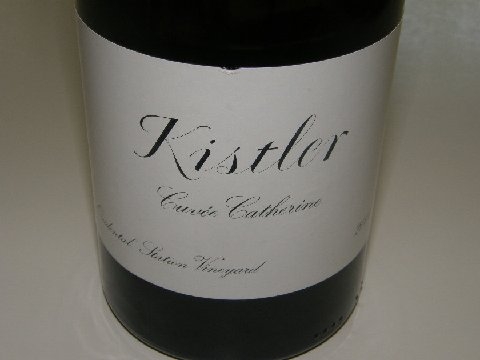 2004 Kistler Cuvee Catherine Occidental Station Vineyard Sonoma Coast Pinot Noir 14.1% alc., 1,000 cases, $90. · This seemed to be an off bottle and clearly the least appealing wine in the lineup. The fruit was muted on the nose and in the mouth. No TCA was detectable by the group. Aromas of green beans and faint berries led to simple dark red fruit flavors, primarily black raspberry, with lively acidity on the finish. Decent tasting but not of “cult” caliber.
Kosta Browne Michael Browne and Dan Kosta are alumni of a noted Sonoma County restaurant, John Ash and Co.. Michael followed a circuitous route to get there. He was born in the San Francisco Bay Area, but grew up in Washington State. Upon returning to Santa Rosa in 1987, he enrolled in prerequisite courses in architecture at Santa Rosa Junior College. During schooling, he worked in wine retail and at a number of restaurants. It was at John Ash and Co. that Michael developed a deep love for wine and food and the agricultural pursuit of winegrowing. His ultimate goal became to make a living as a winemaker. Dan Kosta was a native of Sonoma who grew up around wine. Dan’s father owned a wine store in Santa Rosa and wine was a frequent topic of discussion at the household dinner table. After joining the staff at John Ash & Co., Dan worked his way up to Head Sommelier. He too, had a desire to be involved in a winery, and in 1997, he teamed with Michael to make the first Kosta Browne wine. They put all of their tip money into a “co-op” cookie jar placed in the restaurant’s kitchen. After raising $2,600, they bought a half ton of Pinot Noir grapes, a single barrel, and a used, hand-cranked de-stemmer and crusher to produce their first vintage. The same year, Michael left John Ash & Co. and became assistant winemaker at Deerfield Ranch Winery in the Sonoma Valley. Dan and Michael attracted an initial investment group and in 1999 made 2,600 cases of Lake County Sauvignon Blanc. This venture proved financially unrewarding and the principals parted ways. In 2001, they teamed with Chris Costello and family who provided a fiscally conservative and thoughtful business plan. Success followed shortly thereafter. Michael likes to say he learned his winemaking at “ Hard Knocks University.” It didn’t take him long to achieve a measure of recognition. The 2003 vintage was highly regarded by wine writer James Laube of the Wine Spectator. He awarded all the 2003 Kosta Browne Pinot Noirs scores ranging from 90 to 96. The mailing list quickly filled up and Kosta Browne was on every pinotphile’s radar. Kosta Browne quickly became a member of the band of prestigious Russian River Valley wine producers, many of whom had been crafting notable Pinot Noir since the 1980s. Kosta Browne bounced around, sharing space in several wineries for a while. Today, they have found a home in the old Vacu-Dry apple processing plant in Sebastopol. Here they will be able to further refine their craft and follow their commitment to producing better and better wines. Current production is about 10,500 cases which is comfortable for them. Look for Michael and/or Dan at any of the major Pinot Noir festivals, but get to their booth early as their wines are quickly sucked up by the crowd that bellies up to their offerings. Kosta Browne wines are sold exclusively through a mailing list (there is currently a waiting list for the mailing list). The winery is not open to the public. The Pinot Noirs are highly flavorful and intensely fruity wines. The lineup includes a Sonoma Coast and Russian River Valley appellation bottling and single vineyard wines from Keefer Ranch, Amber Ridge, Koplen Vineyard, Garys' Vineyard, Rosella's Vineyard and Miron Vineyard.
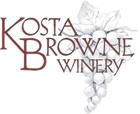 2005 Kosta Browne Kanzler Vineyard Russian River Valley Pinot Noir 15.3% alc., 500 cases, $62. Clones 115, 667 and Pommard. · A beautiful wine with plenty of sweet ripe blue and black fruit wrapped in oak. Sturdy on the palate with firm tannins, yet showing some finesse, and exhibiting a huge, clean finish that leaves a little heat in its wake.
Marcassin Helen Turley is one of the most influential winemakers in California, receiving critical acclaim for almost every wine she touches. Turley has been the consulting winemaker for some of the best wineries in the country – Peter Michael, Colgin, Bryant Family, Martinelli – just to name a few. Marcassin is Turley’s own label owned in partnership with her husband, John Wetlaufer. Marcassin (French for 'young wild boar') does not have its own winery. The wines are crafted at the Martinelli winery in the Russian River Valley. Marcassin’s 10-acre estate vineyard, Marcassin Vineyard, is located on the Sonoma Coast and is planted half-and-half to Pinot Noir and Chardonnay. Fruit for the other vineyarddesignated wines is sourced from other neighboring true Sonoma Coast vineyards (Blue Slide Ridge and Three Sisters for the Pinot Noirs). The winery is very private and not much information is forthcoming. Turley is said to plant her vineyard very densely, severely limit yields, and pick very ripe. In her winemaking, she uses natural yeasts, new oak, and leaves the wines on the lees after fermentation. Stylistically, the wines are big and extracted with noticeable sweetness reflecting generous alcohol. Marcassin produces about 100 barrels of Pinot Noir and Chardonnay, enough for 2,500 cases. The wines are sold to a mailing list which has been full for years (the waiting list is rumored to contain over 5,000 names). Your only chance to obtain Marcassin wines is on the secondary market where they demand among the highest prices for any domestic Pinot Noir (in the range of $300-$350 or more per bottle). 707-942-5633.
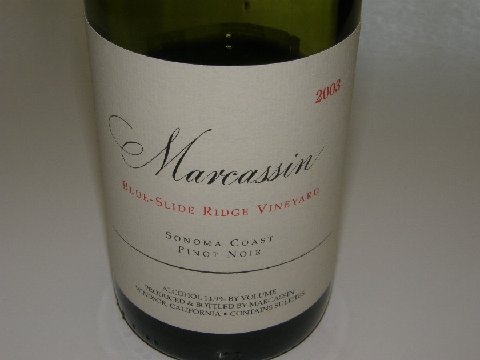 2003 Marcassin Blue Slide Ridge Vineyard Sonoma Coast Pinot Noir 14.9% alc., $ (current retail price from $150 to $595). · Very ripe and prodigious black fruits touched by oak, stems, mushroom, earth, citrus and some noticeable alcohol. The tannins are reigned in and the mouth feel is very dreamy. Good but not exceptional because of the boozy impression that lingers.
Pisoni Vineyards & Winery Winegrower Gary Pisoni comes from generations of farmers who tended row crops long before he was born. Pisonii enjoyed drinking and collecting fine French wines while in college. When he graduated, he was eager to find a way into the wine business. When he told his father he wanted to plant grapevines on the family cattle ranch in the Santa Lucia Highlands, he was met with several objections, not the least of which was the cost. Gary countered to his father, “Have you ever been to a $250 lettuce tasting?” His father relented and a legendary vineyard was born in 1982. Gary’s positive energy has made him a household name among Pinot circles. Gary planted his own-rooted vines in virgin soil. It took ten years of witchers and well drillers to tap into a water source on the sixth try. Water turned the wilderness into a garden and made Gary’s dream come true. The original vines are rumored to be from suitcase cuttings from a famous domaine in Vosne-Romanee, now called the Pisoni clone or selection. Winemaker son Jeff and grape grower son Mark created the Pisoni label, releasing the first estate Pinot Noir in 1998. A second label, Lucia, debuted in 2000. Pisoni fruit quickly became highly prized in California and Pisoni Vineyard put Santa Lucia Highlands on the map, becoming one of California’s true ‘cult’ vineyards. Many top producers craft a Pisoni vineyard-designate Pinot Noir (Arcadian, Capiaux, Morgan, Patz & Hall, Peter Michael, Siduri, Tantara, Testarossa). Gary Pisoni also manages nearby Garys’ Vineyard with Gary Franscioni.
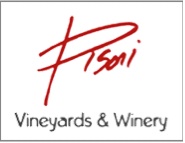 2005 Pisoni Estate Santa Lucia Highlands Pinot Noir 14.3% alc., $65. The grapes for the estate Pinot Noir come from the own-rooted Elias Block portion of the vineyard where yields are very small. Annual production is around 600 cases. · The darkest wine in the lineup. Terrific aromatics emerge over time with the wine showing off perfectly ripe black cherries, cranberries, and smoke. Peppery and earth-kissed dark red fruits cascade over the palate with refined but noticeable tannins leading to a dry finish. Delivers a bolt of fruit flavor.
Ponzi Vineyards Dick and Nancy Ponzi established Ponzi Vineyards in 1970 in Beaverton, Oregon, 15 miles southwest of Portland. Dick has been active in promoting Oregon’s wine industry for years. He was a founding member and first president of the Oregon Winegrowers Association, and served as a founding Director of the Oregon Wine Advisory Board (now the Oregon Wine Board). Nancy helped create the first Discover Oregon Wines guide, co founded the International Pinot Noir Celebration, the Salud Oregon Pinot Noir Barrel Auction and, most recently, Oregon Pinot Camp. In 1997, together they created a regional tasting room and a full service restaurant featuring local wines and food called The Dundee Bistro. Ponzi Vineyards is one of Oregon’s top 20 Oregon wineries by brand in 2007 with an estimated case production of 29,600. Ponzi Pinot Noirs have won critical acclaim through the years. The wines have always been intense, savory and concentrated. Consistency has always been a hallmark, even during the uneven vintages of the 1990s. My Oregon wine epiphany was a 1992 Ponzi Reserve Pinot Noir made from a single vineyard that was 18 years old at the time and I have continued to enjoy many Reserve bottlings since. The three Ponzi children, Michel (Operations Manager), Anna Maria (National Sales and Marketing Director) and Luisa (Winemaker), grew up helping out in the vineyard and in the family’s winery and operate the family business now. They are continuing the family tradition of community and wine industry service. Even their eight grandchildren are now being introduced to viticulture and the operation of the winery at an early age. Luisa is a highly respected winemaker who was trained in Burgundy and now is married to another notable Oregon Pinot Noir winemaker, Eric Hamacher. A new Ponzi winemaking facility is due for completion for the 2008 harvest. It is located closer to the estate vineyards on the east and north faces of the Chehalem Mountains. The property, yet unnamed, is 42 acres and is being designed by Dick Ponzi. The original tasting room will remain at its current location. Ponzi Vineyards has two tasting rooms. The original tasting room is located at the site of the first estate vineyards and winery at 14665 SW Winery Lane in Beaverton and is open from 11-5 daily. Tours are available by appointment (503-628-1227). The Ponzi Wine Bar is located at 100 SW 7th St in Dundee and is open from 11-5 daily (503-554-1500). The wines are distributed by Wilson Daniels and sold on the website at www.ponziwines.com.
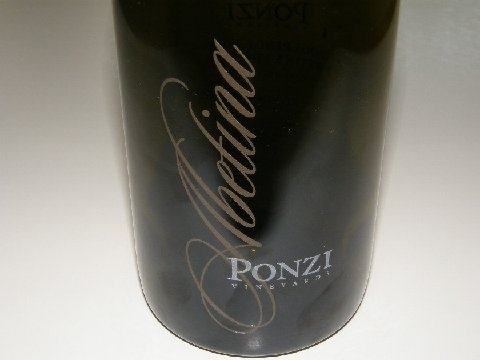 2005 Ponzi Abetina Vineyard Willamette Valley Pinot Noir 13.5% alc., 100 cases, $100, etched . The Abetina Vineyard is a 2-acre vineyard established in 1975 and planted to 20 different Pinot Noir clones. Grapes from this vineyard are often put into the Ponzi Reserve Pinot Noir and a separate vineyard-designate is only made in exceptional vintages. · Redolent with both red and black spiced cherries along with dried herbs and sprinkled with cinnamon, this wine is plush, supple and delicious. There are some unresolved tannins, but they are fine and sweet. This wine charms with its discreet concentrated fruit. A striking wine that is in a class by itself.
Privé Vineyard Mark and Tina Hammond hand craft their Pinot Noirs from two acres of vines planted in 1980 on their estate on Chehalem Mountain. He meticulously manages the vineyard and she crafts the wines in a tiny garage-sized winery on their estate. The first vintage was 2001 and the wines instantly became Oregon favorites. The Hammonds bottle three wines, Le Sud from the South 1 acre, Le Nord from the North 1 acre, and Joie de Vivre, a reserve wine from the best barrels in the winery. Quantities are miniscule and demand is high. The wines are sold only through a mailing list at www.privevineyard.com. One of my favorite Oregon producers.
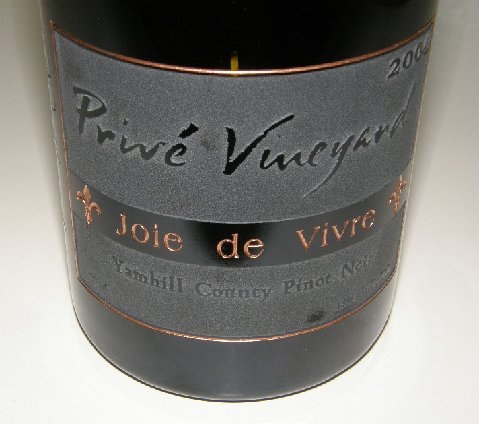 2004 Privé Vineyard Joie de Vivre Willamette Valley Pinot Noir 13.0% alc., 98 bottles, $85, etched bottle. · This wine is the lightest in color and lightest in weight in the lineup. Upon pouring, the nose offers grass and herbs along with black cherry fruit. With time, roasted coffee aromas develop which carry over into the flavors which also include ripe red stone fruits, savory herbs and a hint of mocha. Medium-weighted, this Pinot has commendable balance and a clean finish.
Rivers-Marie Thomas Rivers Brown and his wife Genevieve Marie Walsh have quietly developed one of California’s most cherished Pinot Noir labels. Thomas hails from South Carolina and was educated at the University of Virginia. In college he majored in English literature and game theory, two subjects about as distant from enology as possible. He arrived in California in 1996, loving wine and wanting to play the game, but with no leads or connections whatsoever. He started knocking on doors and finally Ehren Jordan hired him at Turley. This was to become a very fortuitous hire as Ehren subsequently introduced Thomas to Scott and Joan Zeller, the owners of the 6 acre Summa Vineyard in the Occidental region of the true Sonoma Coast. Early on (2002 was the first Rivers-Marie Pinot Noir release), Summa Vineyard was the only source of Pinot Noir for Thomas, but led to other grape acquisitions in the area. Today, Rivers-Marie produces very small amounts of Pinot Noir from three vineyard sources in the true Sonoma Coast, specifically the Occidental-Freestone area. Besides Summa Vineyard, grapes are sourced from the Occidental Ridge Vineyard (owned by Richard and Darla Radcliffe) which debuted in 2005, and the Willow Creek Vineyard (2 acres owned by Raleigh and Patricia Wilson-Juckett) which debuted in 2006. Total production for Rivers-Marie in 2007 is 650 cases. Its no wonder that there are 4,000 people on the waiting list hopelessly bidding their time for a spot on the mailing list. Managing allocations is a lot more difficult than crafting the wines. Thomas also has a hand in crafting wine for fifteen different wineries in Napa, processing 300 tons of grapes annually, primarily Cabernet Sauvignon. He plans to move his own production to the Black- Sears Winery on Howell Mountain in Napa that Ted Lemon of Littorai is leaving behind (Ted’s new winery opens later this year). Thomas has a second Pinot Noir project with partners, Aston Estate, sourcing Pinot Noir from the Annapolis region of the true Sonoma Coast. Rivers-Marie wines are sold exclusively through a mailing list which has been full for some time now. You can add your name to the waiting list at www.riversmarie.com, but you might be better served to seek out a few bottles on the secondary market. A Chardonnay from Thieriot Vineyard located in the true Sonoma Coast will be available in 2007. There is also a Rivers-Marie Cabernet Sauvignon from Howell Mountain.
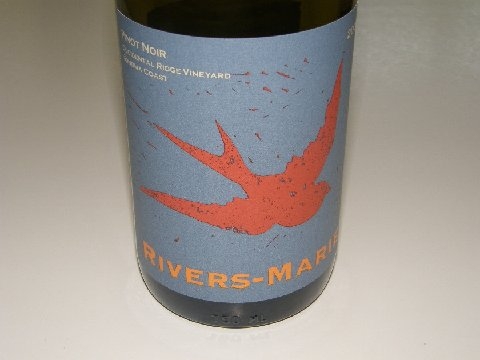 2006 Rivers-Marie Occidental Ridge Vineyard Sonoma Coast Pinot Noir 14.2% alc.,140 cases, $40. Clones 115, 667, 777. Aged in 67% new oak. · Pie-spiced black cherries and cola carry the show from start-to-finish. A complimentary citrus note adds zip and zing to the finish. All silk and satin with an appealing elegance unique among this lineup of wines. This wine will match much better with food than several of the heavyweight cult wines tasted because of its lively acidity.
ROCO In 1987, Rollin Soles hatched the Argyle Winery and the same year he purchased a hillside property in the Chehalem Mountains. It was many years later, in 2001, that Rollin and his wife Corby planted a 7-acre Pinot Noir vineyard on the property and named it Wit’s End Vineyard. The vineyard is uniquely situated to take advantage of the protection afforded by the Chehalem Mountains which shield the vineyard from winter Arctic winds and the Dundee Hills to the south which temper the wind from the Pacific Ocean. The vines are planted at a high density and three Dijon clones make up the mix. The Wit’s End Vineyard has been a family project of great pride and Rollin and Corby farm the property with utmost care and attention. Beginning in 2003, they produced four barrels of Pinot Noir meant for family and friends under the ROCO (rock-oh) label and called Private Stash. Beginning in 2004, Soles has crafted two Pinot Noirs, a ROCO Willamette Valley bottling and the ROCO Private Stash. A small amount of the wines is released to the public each vintage. The thunderbird image on the ROCO label is a reproduction of an ancient petroglyph removed from the Columbia River George in the 1950s. The bird image is said to represent the “wild essence and intriguing history of the Pacific southwest and ROCO wines.” ROCO Pinot Noirs are available in limited quantities on the website, www.rocowines.com. 503-538-7625. Recently, a vertical of all three of the Private Stash Pinot Noir vintages were offered for sale on the website.
 2005 Private Stash Willamette Valley Pinot Noir 14.5% alc., $75, screw cap. · Complex perfume of confected black cherries and berries, exotic flowers, and understated charred oak. With air, the nose broadens and intensifies. Rich arsenal of tasty dark Pinot fruits with great purity and vigor. Finishes clean with lively clarity. Brilliantly crafted with pinpoint balance.
Sea Smoke Cellars Proprietor Bob Davids bought 350 acres of the Rancho Chabuchu in the western end of the Sta. Rita Hills appellation in 1998. The next year, 100 acres were planted primarily to Pinot Noir with a small block of Chardonnay. Located on south-facing hillsides above the Santa Ynez River, the vineyards receive plenty of midday sun exposure and evenings are blessed with maritime fog (so-called “sea smoke”). The estate vineyards overlook Fiddlestix Vineyard and further south, Sanford & Benedict Vineyard. There are ten clones of Pinot Noir planted including Dijon 113, 115, 459, 667, and 777, and 2A, Pommard 5, Mt Eden, 09 and 16. The first winemaker beginning with the 2001 vintage was Kris Curren who left in 2008 to work at Foley Estates. There are three bottlings of Pinot Noir: Botella, Southing, and Ten. Sea Smoke Pinot Noirs are sold almost exclusively through a mailing list at www.seasmokecellars.com. 805-737-1600.
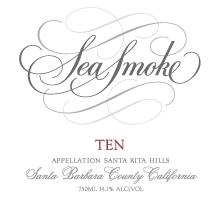 2002 Sea Smoke Ten Sta. Rita Hills Pinot Noir 14.5% alc., $ (current secondary market retail prices from $225 to $300). The inaugural vintage of Sea Smoke Ten which is composed of all ten clones planted on the Sea Smoke estate. Aged 18 months in 100% new French oak. · Plenty of confected fruit with aggressive oak on the nose. Medium-weighted dark fruits with hints of raisin and oak. Smooth and soft with fine tannins on the dry finish. Decent but not exceptional.
Sine Qua Non This is a tiny producer and one of California's true cult wineries. Established in 1994 in Ventura, California by ex-restauranteur Manfred Krankl and his wife Elaine, the wines have brought raves from the wine press and the mailing list filled up long ago with hundreds of names lingering on the waiting list. The wines are unique because each is assigned a different name for each vintage, the labels feature unusual label artwork done by Krankl himself, and wildly different bottle shapes are used. Each bottle is a work of art. Krankl made eight vintages of Pinot Noir from Shea Vineyard in Oregon, and two vintages of Pinot Noir in 2005 and 2006 from grapes sourced in the Sta. Rita Hills. He has discontinued his Pinot Noir program to concentrate on Rhone varietals and desert wines and plans to eventually source all wines from estate-grown grapes. The winery is not open to the public. There is a very informative interview of Manfred Krankl posted on Grape Radio. Your best bet for obtaining the wines is the secondary market and be prepared to open your wallet. Are they worth it? Well, the few Sine Qua Non Pinot Noirs I have had were distinctive and outstanding. They are quintessential neuvo-California Pinot Noir with plenty of ripe fruit extraction, generous alcohol, and seductive textures. Not for the faint of heart and unlike anything from the Old World.
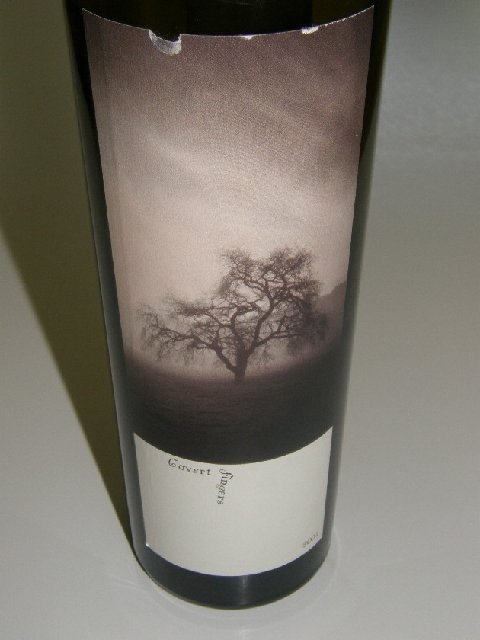 2004 Sine Qua Non Covert Fingers Sta. Rita Hills Pinot Noir 14.9% alc., $ (current retail price from $245 to $450). · The powerful black raspberry and blackberry perfume practically knocks you over. Huge, jammy, powerful black fruits that are very flashy. Rather linear and lacking nuances, but oh what a ride. Well integrated tannins, smooth texturally, and sporting a long, chewy aftertaste with a hint of black coffee. A hedonist’s delight.
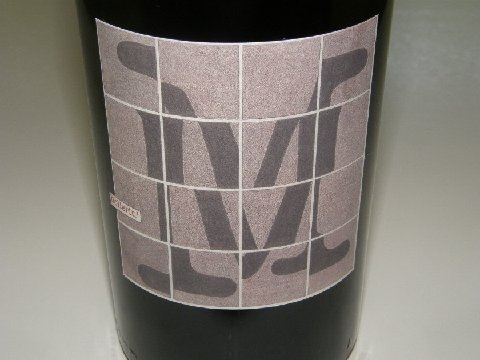 2002 Sine Qua Non Hollern’ M Shea Vineyard Willamette Valley Pinot Noir 15.4% alc., $ (current price from $345 to $499). · I have had this wine on three other occasions over the past few years and it has never failed to impress me. A haunting nose of exotic dark berries with oak, musk, earth, charcoal, minerals and a little heat. Brassy dark velvety fruit that is rich, flamboyant and sumptuous. The tannins are suede-like and the wine caresses the tongue like a fur coat. My only complaint is that you can’t drink much of it at one sitting.
The Long and Winding Pinot RoadOn Christmas Eve 2007, I sat down to dinner with my family for a “traditional” Southern California holiday meal: chips and guacamole, salsa, tamales, refried beans and Modelo Negro beer. As we ate, I reflected upon where I started, how far I have come, and where I plan to go next year. I never drank wine growing up. Like most families in the 1950s, beer and cocktails were the drinks of choice for most adults. Alcoholic beverages were rarely seen on the dinner table, except for maybe an occasional beer when chili was on the menu. I can’t remember when I first drank a dry wine, but I think it was Champagne brought to my house by my French aunt. The quartet of wines I remember most fondly had a little sweetness. Mateus was a moderately dry rosé wine from Portugal. The story goes that the wine was invented in 1942 by Fernando Van Zeller Guedes whose family made Port and grew Vinho Verde grapes. Mateus was really the “in” drink in the 1960s and at one point the wine made up 40% of Portugal’s export income. Practically every college-age person had an empty Mateus flask that was converted into a candle holder. I also downed many bottles of another similar drink, Lancers, which had become wildly popular by the early 1970s. André Cold Duck was still another star during the 1960s, a slightly sweet sparkling wine made by Gallo from Concord grapes that was guaranteed to provide an agonizing hangover the next day. Blue Nun was the wine to order on a date. It was packaged in an impressive slim tall bottle and had a label that read Liebfraumilch (“Milk of Our Blessed Mother”). Again, this generic white wine was slightly sweet, but even better, it was cheap and low in alcohol. As I progressed through the end of high school, college and medical school during the 1960s, there was no such thing as a “varietal” wine in California. It wasn’t until 1974 that Gallo made the first varietal wines such as Hearty Burgundy and Chianti. Four years earlier, in 1970, my world would be transformed.
  The year 1970 was memorable for me. I was living humbly in a studio apartment close to the hospital where I was interning. My girlfriend was a flight attendant (the proper term back then was stewardess) for TWA. I was working my tail off, but when our busy schedules allowed, I would eagerly pick her up after a long flight at Los Angeles International Airport. We would stop at the market and buy some food as well as a jug of Spanada. Spanada was one of a long line of wines blended with fruit introduced by Gallo. It was the original Spanishsounding wine. Spanada had been first introduced in 1970 at a time when the country was changing tastes from dessert to table wines. We spent many marvelous evenings together at a tiny two-seat kitchen table, eating simply and drinking Spanada. The Spanada inevitably led to romance and I thanked Gallo many times for that. In 1970 I traveled to Northern California to visit some friends, including a doctor who collected wine. He had a cellar in his home stocked with fine Bordeaux and Burgundy. I had never seen anything like it in my life. He could tell I was awestruck and generously gave me a bottle of Burgundy (I spelled it “Burgandy” at the time) to take home. One night my girlfriend and I decided to skip the Spanada and open the Burgundy. I did not have a corkscrew and had to borrow one from a neighbor. Remarkably, it was like no wine that had every passed across my lips. The label was strange and foreign, and I remember the words Cote de Nuits, but regretfully not any other details. It was seductive, delicate, beguiling, alluring, complex and aromatic. It was an epiphany. We polished off that bottle in no time and so began my love affair with Pinot Noir. I kept that empty bottle on my kitchen table until I moved out after internship without a remembrance of the exact producer, vintage or vineyard. I was beginning a residency in ophthalmology that offered an increase in salary and the prospects for further wine indulgences were dancing through my head. My girlfriend and I parted ways, but I discovered the wonders of well-stocked liquor stores and began to look for that elusive bottle of “Burgandy.” In my price range, the pickings were slim, and the ones I could afford were thin, rustic, acidic and terribly disappointing. There wasn’t much California Pinot Noir worth pursuing in the early 1970s. Some early signs of success were coming out of Mt. Eden and Chalone, but these were off my radar and might as well have been on another planet. I was thoroughly frustrated at this point, so I looked to the dark side, and began to dabble in Cabernet and Petite Sirah. I was particularly drawn to Petite Sirah because of its bold sweet blackberry jam flavors and black pepper spice. It seemed to be a perfect accompaniment to my culinary skills which consisted primarily of grilling steaks on the barbecue. There was one producer of Petite Sirah in particular that caught my attention - Concannon Vineyard. Maybe it was the fact that Concannon was the first California winery to label the varietal Petite Sirah on the bottle (1964), or maybe it was because the winery had some familiar kinship (founder James Concannon was born on St. Patrick’s Day in Ireland, the homeland of my great grandfather). Most likely, though, it was because I liked the masculine wine, and as a young bachelor, identified with its machismo style. Concannon Vineyard, located on the East Bay of Northern California in Livermore, was the first winery I ever visited. It was around 1974 when I traveled to Concannon and bought a case of wine, one of life’s rites of passage.
 The father grape of Petite Sirah is Syrah and the mother is Peloursin, a humble grape from southern France. Since cross-regional breeding of grapes was frowned on in France, Petite Sirah was not accepted there and found a new home in the United States, where along with Zinfandel, became America’s own varietal. It was initially brought to America from France in the 1889s. Petite Sirah survived phylloxera in the 1890s, both World Wars, the Depression and Prohibition (Petite Sirah was a main ingredient in sacramental wines). I began medical practice in 1975, and my marriage in 1977 and two sons who followed shortly thereafter took my attention away from wine for a few years. Mr Stox Restaurant would revive my passion. In 1977, brothers Ron and Chick Marshall bought an existing restaurant with the peculiar name of Mr Stox in Anaheim, California. They quickly converted it into a destination dining mecca for foodies and wine lovers. The Marshalls amassed an impressive collection of wine and in 1983 received the Wine Spectator Grand Award, an award they retained up to recent times. Comfortably married and established in my medical practice in the early 1980s, I began to take a renewed interest in wine. I attended many winemaker dinners at Mr Stox, the most memorable of these featured the wines of Domaine de la Romanee-Conti (DRC). I had became interested in Chalone Pinot Noir. Chalone had developed a cult following in the 1970s and the wines were quickly snapped up by wine fanciers of the time. Owner and winemaker Richard Graff had acquired the Chalone property which was located on a wind-swept plateau in the Gavilan Mountains, a remote outpost 50 miles east of Monterey. Graff chose the site because of its volcanic soil underlain with limestone. Graff’s winemaking was modeled after Burgundy and his Pinot Noirs reminded me of the DRC wines I had tasted at Mr Stox. The Chalone Pinot Noirs were fermented with stems giving them structure. They were aged 18-24 months in the same French oak barrels that were used at DRC. The barrels were kept in caves that were cool and dark. Later, the wines were put into bottles made in France from a special Burgundy mold. I was particularly fond of the Reserve Pinot Noirs that were first produced in 1978. They were focused, tight-knit, and well-balanced with many layers that revealed themselves slowly with each sniff and sip. The Reserve Pinot Noirs were produced exclusively from old vines on the property and were sold only to shareholders of Chalone stock. I soon became a shareholder and enjoyed many vintages of Chalone Reserve Pinot Noir as well as the rowdy annual Chalone shareholders meeting. In the mid 1980s, another winemaker was making a name for himself and I took notice: Gary Farrell. My love affair with Pinot Noir was now fully engaged, and I was looking for a new source I could hitch my grape-wagon to. In 1989, Dan Berger wrote a glowing report in the Los Angeles Times, calling Gary Farrell a “Pinot Noir Superstar.” In the article, he listed the best Russian River Valley Pinot Noir producers at the time as Joseph Swan, J. Rochioli, Davis Bynum, Williams and Selyem, Laurier, Dehlinger, Mark West, Iron Horse and De Loach. The best of the bunch according to Berger was Gary Farrell. Berger noted that Farrell’s 1988
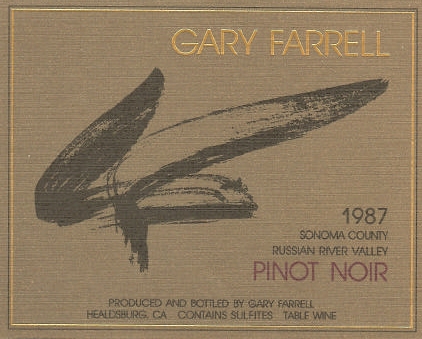 Sonoma County Pinot Noir ($15) was superb, but the 1988 Allen Vineyard Pinot Noir ($25) was a killer and “one of those rare treats worth the price.” In the article, Farrell said, “There are probably fewer than 500 acres of top-quality Pinot Noir vineyard land here. The Russian River hasn’t gotten the publicity of some other areas, but that’s ok. Actually, we’re trying to keep this thing quiet because of the limited acreage out there.” I had sniffed out Farrell even before the glowing article written by Dan Berger, having acquired my first bottles of 1987 Gary Farrell Russian River Valley Pinot Noir ($20, see label above) several months before the article’s publication. This wine was produced from 40% Howard Allen Vineyard, 40% Bacigalupi Vineyard and 20% Rochioli Vineyard, all located within a few miles of Healdsburg. The grapes were hand-harvested early, gently destemmed taking caution not to break the skins on approximately 50% of the berries. The grapes were fermented in small two ton lots using Ashmanchausen yeast for 8 days, inoculated with MCS ML bacteria at 12° Brix. Pressing occurred at dryness and the wine was allowed to settle for four weeks before barreling. The wine was then aged for 14 months in 30% French oak barrels. I became a steady customer of Gary Farrell and his wines accumulated numerous accolades and medals over the years. I was thoroughly charmed by their enticing aromas, lush and broad fruit flavors, modest tannins and sweet oak highlights. My loyalty never wavered, but there was another Russian River Valley producer who stole my heart away in the early 1990s. Liking Pinot Noir in the early 1990s practically labeled me an eccentric. To most wine lovers of the time, Pinot Noir was an afterthought - a weak substitute for Cabernet Sauvignon and Merlot. For me, Pinot Noir was the
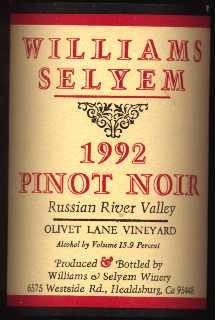 Holy Grail, the most sensual of all wines, and I was determined to pursue my love affair with it. Burt Williams and Ed Selyem were producing magical Pinot Noirs out of a small garage on Fulton Road in Santa Rosa. There had been significant press since 1985, touting the quality of the Pinot Noirs they crafted from vineyards with now-magical names like Rochioli, Allen, Hirsch and Olivet Lane. It was a 1992 Williams Selyem Rochioli Vineyard Pinot Noir that had such a powerful charisma for me that even today I can taste the wine, and clearly believe it was the greatest California Pinot Noir I have ever had in my life. I reached my fiftieth birthday in 1993 and decided to have a celebratory degustation dinner at The Pacific Club in Newport Beach, California. My friend and sommelier extraordinaire, Rene Chazottes, planned the food to accompany my wine choices. It was Rene who made me understand that wine, alone above all other beverages, is part of food and neither wine nor food exists in even half its glory without the other. As Renee used to say, “Wine is made for drinking with food and when you have the perfect match, that is it, the 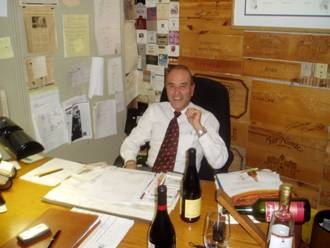
 A wine group was formed in January, 1989, as a monthly gathering of wine enthusiasts. The instigator was Ron Marshall, proprietor of Mr. Stox Restaurant in Anaheim, California. The guidelines proposed insisted “Members have a serious interest in wine, have their own wine collection, and have a desire to enhance their palate and wine education through group tastings.” The premise was that this was not to be a pompous group of wine snobs and “good jokes would be encouraged at all tastings.” The origin of the group’s name, Le Grand Crew, is lost in history. Le Grand Crew was a major source of my wine education and inspiration and the group, with few member changes, has persisted to the present time. Meeting monthly over dinner, we (women were not specifically banned but few dared to attend) tasted all the world’s greatest wines and developed friendships for life. Early on, I was an outcast and weirdo in Le Grand Crew, the butt of many jokes for my professed love of Pinot Noir. The members were dedicated Cabernet and Bordeaux drinkers with little interest or patience for other wines. That was all to change, when in 1991, I organized my first “Superbowl of Pinot Noir” dinner tasting. The idea was to present the champions, the best of the best New World Pinot Noirs, currently available in the marketplace. Over the years, the members looked forward to the “Superbowl,” and many abandoned the dark side for Pinot Noir. The wines at “Superbowl I of Pinot Noir” were the following: 1987 Au Bon Climat Sanford & Benedict Vineyard Santa Ynez Valley ($30), 1987 Calera Jensen Vineyard Hollister ($30), 1987 El Molino Napa Valley ($30), 1987 Williams Selyem Rochioli Vineyard Russian River Valley ($40), 1988 Gary Farrell Allen Vineyard Russian River Valley ($25), 1988 Robert Mondavi Reserve Napa Valley ($29), 1988 Signorello Proprietor’s Reserve Napa Valley ($25), 1988 Williams Selyem Sonoma Coast ($25), 1989 Byron Santa Barbara County ($18), 1989 Etude Napa Valley ($22), and 1989 Williams Selyem Olivet Lane Vineyard Russian River Valley Pinot Noir ($25). Looking back, it was a heck of a lineup, and a glimpse of Pinot history. 1993 had arrived and I was hosting Super Bowl of Pinot Noir II. It was a time when the wine cognoscenti were awakening to American Pinot Noir. American producers were beginning to wave the flag proudly, sticking their chests out, proclaiming how good home grown Pinot Noir from California had become. The event that turned Pinot Noir’s future happened in the early 1990s and involved an eleven-letter word. California’s most notable Pinot Noir winemakers became winegrowers. This one word led to a revolution in philosophy and practice and the results led to quantum leaps in quality. Gradually, Pinot Noir escaped the unflattering title of “heartbreak grape.” Under-ripe, pale, green and vegetal examples became distant memories. The most talented workers in American wine now wanted to craft it and the most enlightened drinkers wanted to consume it. Super Bowl II of Pinot Noir, “Second Encounter of the Pinot Kind,” was held at the now shuttered Gustav Anders Restaurant in Orange County, California. I had searched far and wide to find the best from the 1991 vintage and the lineup was memorable: 1991 Domaine Drouhin Oregon Willamette Valley Pinot Noir (first vintage), 1991 Ponzi Reserve Willamette Valley Pinot Noir, 1992 Beaux Freres Willamette Valley Pinot Noir (first vintage), 1991 Saintsbury Reserve Carneros Pinot Noir, 1991 Schug Heritage Reserve Carneros Pinot Noir, 1991 El Molino Napa Valley Pinot Noir, 1991 Rochioli Estate Russian River Valley Pinot Noir, 1991 Williams Selyem Allen Vineyard Russian River Valley Pinot Noir, and 1991 Sanford Sanford & Benedict Vineyard Santa Barbara County Pinot Noir. My wine drinking buddies, most of whom had been raised on California Cabernet Sauvignon, were a little surprised by the full, deep, rich scents and flavors in the lineup of Pinot Noirs that seemed lacking in extract, body and color. They found Pinot Noir very hard to say no to, seduced by its sensually indulgent nature that melded together delicacy and intensity like no other grape varietal they had experienced. American Pinot Noir was proving its worth and my passion for it had been vindicated. It was time to visit the cradle of Pinot Noir, the slopes of the Cote d’Or. Master Sommelier, Rene Chazottes, led a small group of wine enthusiasts on a wine and gastronomic tour of France in June of 2000. Our group’s battle cry was “Mon verre est vide!” (my glass is empty). 1 Bus, 2 drivers, 4 hotels, 15 winos, 18 wineries, 22 cities, 24 meals, 185 wines, and 370 bottles of wine from Champagne to Burgundy to the Loire Valley and finally Bordeaux. For me the highlight of the trip was the heartwarming sight of the almost unbroken vista of vines carpeting the slope of the Cote d’Or on a glorious sunny day. As we drove leisurely along RN 74, the most evocative signs to villages appeared, the names of which sounded like a roll call of the most voluptuous red wines in the world: Chambolle-Musigny, Vougeot, Vosne-Romanee, and Nuits St. George. At Louis Latour in Aloxe-Corton I drooled over the library of Burgundies dating to the 1800s. Bottles with no labels and covered in mold were stacked in dank, musty cellars, unmoved for generations. The winemaker’s thief was put into action and I tasted some outstanding 1999 vintage wines including Corton Charlemagne and Chambertain. Not surprisingly, I did not spit these wines out. Later that day, we continued south along the Cote de Beaune to the lovely, old, and very rich town of Beaune with its perilously narrow streets, medieval houses, grandiose mansions and a Romanesque church. We settled in at the Renaissance mansion hotel, La Cep, close to the action in central Beaune. It was then off to Vougeot for a tasting and dinner at Domaine Bertagna. With only 200 inhabitants and 67 hectares of vines, Vougeot is the smallest commune in the Cote d’Or. Vougeot’s reputation rests principally on the vines from the walled vineyard known as Clos de Vougeot, the largest clos in the Cote d’Or. A spectacular dinner ensued at Domaine Bertagna. Featured wines included 1995 Domaine Bertagna Corton Charlemagne, 1995 Domaine Bertagna Clos St Denis (Magnum), and 1995 Domaine Bertagna Vougeot Clos de la Perriere, Monopole, 1er Cru. We drank, ate and sang the “Ban de Bourgogne.” I was beginning to feel at home in Burgundy. I awoke after our previous night’s revelry at Domaine Bertagna and decided to walk off my lovely Pinot hangover. I started to think that I had died and gone to heaven. Many would remark, “give me a break, it’s only a bottle of wine.” Right, and a Ferrari is only a car and the Rolling Stones are just a rock band. Some things just become the standard by which all else is measured, and I realized for Pinot Noir, that standard was Burgundy. Although California Pinot Noir compares favorably in many cases with Burgundian wines, some are to Burgundy what the World Wrestling Federation is to athletics. This is not to say that we should spend needless energy on comparing North American Pinot Noir to Burgundy. They should both be enjoyed for the qualities that they exhibit, and to suggest they are comparable is a disservice to both. A visit to Burgundy is magical. The rich simplicity of each Domaine’s houses and the purity of line of the stone enclosures surrounding the vineyards clings to my memory. The history, tradition, and intimacy of the beautiful farm-based countryside make the wines seem even more magical. Some people call Burgundy “liquid silk,” others say it is as close as you can get to a romantic interlude with your clothes on. In either case, fine Burgundy is a kaleidoscope of flavors and heady aromas that will spin your head around, set your pulse racing, and leave your totally at peace with the world, if not a bit breathless. Every dedicated pinotphile seems to have begun their journey of discovery after tasting a remarkable Burgundy. I am no exception and my travel to the “motherland” only reinforced my epiphany. As I flew home from Paris, I was reminded of what Louis Trebuchet had remarked after our group polished off thirty-four bottles of fine white Burgundy at a luncheon at Domaine Chartron et Trebuchet in Puligny- Montrachet: “Bordeaux makes women say things they shouldn’t say; Burgundy makes women do things they shouldn’t do.” I glanced over at my wife longingly, eager to return to home in California. The inspiration and derivation of the name of my newsletter, the PinotFile, is lost in my memory. I do know that I sat down on a Sunday night, April 22, 2001, and began to type a one page “newsletter” on Pinot Noir that I intended to send out to the twenty members of my wine club, Le Grand Crew. I alerted my inaugural readers as follows: “Every Sunday night I am going to e-mail a short newsletter titled the PinotFile to keep you apprised of news in the pinotphile world: new releases, new producers, ratings (Note: I have never believed in or given wines numerical scores but did initially report the scores of others. I have long since discarded this practice), what to buy, what not to buy, winemaker profiles, winery news and so on. If you could care less, too bad, you have been pinot-spamed.” From the beginning, humor has played a large part in the PinotFile. The initial issue featured a humorous review that was borrowed in part from a Wine X magazine transmission. “1999 Viagra Cellars Pinot Noir. Special Family Library Private Reserve, Olive Grove Vineyard, Southwest Facing Slope, Behind the Barn, Vertical Cordon Trellised, Fifth Row, Third Vine from the Right, North Cane, First Bunch from the Left, Unfined, Unfiltered, Barrel Aged, Barrel Fermented, Estate Grown, Estate Bottled, Estate for Sale. Winery founded in 1981 by a fifth generation billionaire. $110.99.” The review went on to say, “I don’t know why I should bother trying to explain such a great wine to mere mortals such as you. It’s like explaining rain to people who don’t know what water is. Nevertheless, I will attempt to describe the wine. At first whiff, there is an attack of acidhyrolsates, vindaloo paste, and ciruela. The aromas are very feminine and may make some question their sexuality. The wine explodes in the mouth, saturating the palate and I am certain this is a masculine wine in drag. But it is good and a wine to remember. 1,000 cases produced, but not for sale - it is the family’s private reserve!” I finished the single page, hit the send box, and the PinotFile was off and running. After 53 issues sent out weekly in a one to two page format, the PinotFile took on a four page newsletter look in June of 2002 and a rudimentary website was begun with a logo created by graphic designer, Steve Muller. In one of the early newsletters, I wrote a feature titled, “Lust and Pinot,” reproduced here.
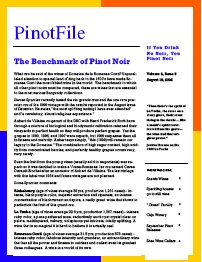 Pinot’s powerful smells can bring men and women together, and maybe that is why God invented wine. Wine is powerful both from the effects of alcohol, and from the smell. There are only four basic tastes, but the average person can perceive thousands of different smells (some very sensitive noses can detect up to 10,000). Hundreds of different smells from organic compounds have been identified in wine. The olfactory glands in the nose are directly connected to our frontal lobes in the brain which do most of our serious mental work as well as functioning as the emotional part of our brain. Smells, then, can set off very powerful memories and feelings and help unlock natural urges. When combined with the psychological effects of alcohol, smells can turn any plain mousy blond into Madonna. Research has suggested that the pheromones in certain grape varieties, especially Pinot Noir, are very similar to human sex pheromones. All the smells in the Pinot Noir grape such as spice, earth, and musk, are smells associated with the principal male smell, andosterone. The key female smells are thiethylamine and isovaleric acid which are characterized by fish and cheese odors respectively. Australia’s randiest winemaker, Max Lake, once suggested that isovaleric acid can be simulated in Champagne and soft cheeses. What all of this proves is what we have know for years: Champagne and Burgundy will get you a sure thing. If it wasn’t for all of those pheromones and wine, we probably would still be apes. As the years and weekly issues rolled by, I was infusing the PinotFile with a purpose. I chose to circumvent the many wine publications of the time which primarily centered on lengthy lists of tasting notes and scores. My intent was to find and report the compelling stories behind every good bottle of Pinot Noir. Because of the serious commitment in time, effort, and money that Pinot Noir producers put into the bottle, I avoided writing derogatory reviews of Pinot Noirs that were not particularly appealing to me. I strove to give a truthful judgment and only feature and recommend Pinot Noirs that I deemed worthy of reader interest. I have received a continuous stream of testimonials from grateful readers who seem happy with my unpretentious and humorous approach to reviewing wine, and I am truly appreciative of every one. W.S. Merwin wrote, “I asked how can you ever be sure that what you write is really any good at all……..If you have to be sure don’t write.” The feed back I have received has spurred me on and given me some surety. I especially enjoyed this commentary: “If I drank over 1,300 wines during the year, my wife would accuse me of having a drinking problem. You do it, call it research, brag about it, and gain respect among your friends. Way to go!” The PinotFile currently has readers from all over the globe including Australia, Canada, the European Union, France, Germany, Great Britain, Hong Kong, Japan, Netherlands, New Zealand, Peru, Singapore, Spain, Sweden, Switzerland, and many other countries as well. I have now published 318 issues of the PinotFile including this issue. It has been a long and joyous road well-travelled, but its time to pull the cork on a new venture.
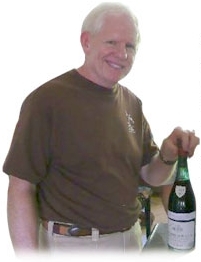
Pinot BriefsRoessler Cellars New Winery Owned by brothers Roger and Richard Roessler and San Francisco restauranteur Kevin McNeely, Roessler Cellars has been crafting wines at Copain Custom Crush in Santa Rosa since 2000. Plans are now afoot to build a $6 million dollar 6,500-square-foot winery, 7,700-square-foot barrel storage facility, and 4,800-square-foot hospitality center and offices southwest of Sonoma. The winery will be located in the Petaluma Gap area alongside Pinot Noir and Chardonnay vineyards. Roessler Cellars plans to increase production to 12,000 cases over the next few years. Under the direction of winemaker Scott Shapely, Roessler Cellars currently produces sixteen different Pinot Noirs including both appellation series wines and vineyard-designates. (northbaybusinessjournal.com, August 25, 2008).
 Lett Retires Known to Oregonians as “Papa Pinot,” David Lett had his retirement party the day before the International Pinot Noir Celebration at the end of July. Sixty-five people were invited to a 37-year vertical tasting of every Eyrie Vineyards Reserve Pinot Noir, from the first in 1970 (Lett did not think it was worthy of the label, “Pinot Noir,” so he named it “Oregon Spring Wine), to the most recent 2006 release. Lett has always held true to his own vision for Pinot Noir and his wines have been distinctly different from most others made in Oregon. According to Michael Alberty (a close friend of Lett’s and owner of Story Teller Wine Company in Portland), “Through thick and thin, no matter what the critics wrote, no matter what the new trend was, David kept making Pinot Noir the way he thought best.” Lett’s style was never flashy and bold, rather he preferred leaner wines with good acidity that performed well at the table and aged magnificently. David’s son Jason, took over management of the winery in 2005, making the 2004 vintage the last crafted by David. The winery’s website is www.eyrievineyards.com Alcina Cellars Online As you readers know, I am a fan of the recent releases from Greg Piatigorski at Alcina Cellars. Greg has now updated and expanded his website, offering online ordering of wines, expanded tasting notes with continuous updates, and useful links. There are still small amounts of the 2006 Pinot Noirs available and two 2006 Syrahs have now been released. Look for new labels displaying paintings by a talented Russian artist in coming vintages. Visit the website at www.alcinacellars.com.
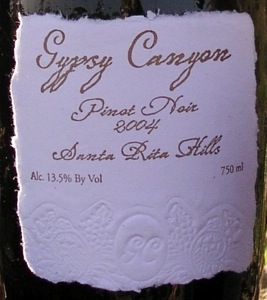 Gypsy Canyon Last Call The enthusiasm for the small amounts of Gypsy Canyon wines has created a demand exceeding production. Proprietor and winemaker Deborah Hall is still accepting a very limited number of new subscribers and a wait list is being started. Production in 2006 was only 100 cases plus 120 magnums of Santa Rita Creek Pinot Noir. In 2007, deer harvested most of the grapes and the resultant wine was declassified. Pinot Noir has now been grafted to some of the ancient Mission grape vines on the property and the Nineteenth Century Sta. Rita Hills Pinot Noir will be released in 2011 to lucky subscribers. Visit the website at www.gypsycanyon.com. Domaine Alfred Changes Owners Domain Alfred, one of California’s top producers of Pinot Noir and Chardonnay, was started by Terry Speizer in 1994. At the time, Speizer had just sold his semiconductor company and was looking for a new entrepreneurial opportunity. Now Speizer is interested in pursuing solarpowered business interests. The new owners are Crimson Wine Group, who already own Pine Ridge Winery in Napa and Archery Summit in the Willamette Valley of Oregon. Winemaker Fin du Fresne, who has been at Domaine Alfred since 2006, will continue with the winery. 24,000 cases of primarily Pinot Noir are produced. Mendocino County Fair Wine Competition 54 wineries entered 255 wines, all crafted from Mendocino County wine grapes in the 32nd annual wine competition. Double Gold medals were awarded to 2006 Parducci Wine Cellars Anderson Valley Pinot Noir and 2006 Standish Wine Co. Mayflower Pinot Noir. Gold Medal winners included 2005 Cakebread Cellars Anderson Valley Pinot Noir and 2005 Raye’s Hill Henneberg Anderson Valley Pinot Noir (a great wine!). To see the full list of 2008 medal winners, visit www.mendowine.com.
PinotHarvest.com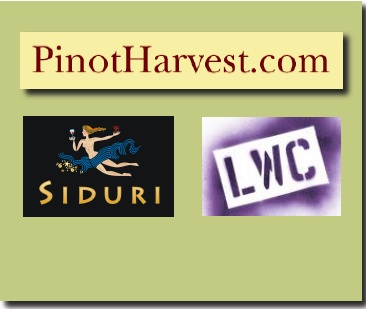 A new website has been developed by Adam Lee of Siduri Wines and Brian Loring of Loring Wine Company. This site is the first ever Pinot Noir dedicated grower and winemaker group blog from the front lines of every major West Coast Pinot Noir appellation from Oregon’s Willamette Valley in the North to California’s Sta. Rita Hills in the South. The website will go live on August 20th and from that day until November 1st, PinotHarvest.com will be updated daily by a collaboration of top Pinot Noir winegrowers and winemakers including: Andrew P. Vingiello, Sam Tannahill, Joe Davis, Anna Matzinger, Mark McWilliams, Jim Clendenen, Jeff Gaffner, Wes Hagen, Peter Cargasacchi, Michael Browne, Brian Loring, James Hall, Adam and Diana Lee, Mike Sinor, and Ryan Zepaltas. The website will be a collective of harvest experiences and insights and visitors to the sight can check in daily for regular updates from their favorite vineyards or appellations.
Join the CrewYou may purchase an annual subscription to the PinotFile anytime after September 5, 2008, using a secure credit card transaction through PayPal. Use the “Join the Crew” button on the website. The Prince of Pinot home website at www.princeofpinot.com will be freely accessible until October 5, 2008. After October 5, only limited access will be offered to non-subscribers. Subscribers will have free access using an id and password. The biweekly newsletter will no longer be e-mailed to subscribers. Rather, you will receive notification by email (from princpinot@gmail.com) when a new issue is on the site. Please configure your spam filters appropriately so you will reliably receive this communication. You can then read, download, and print a copy of the PinotFile. Past issues will always be available for reference and reading. You may also sign up for a RSS feed to be notified immediately when a new issue or other information is posted on the site. An annual subscription consists of 26 issues: over 500 pages of pinotspeak and unlimited access to bonus online content. An automated notice will be sent by e-mail to you at the time of expiration of your subscription alerting you to renew. When you subscribe, you will receive an e-mail confirmation from PayPal and your subscription will be immediately made active. If you have any problems with obtaining your subscription or navigating the website, please contact Peter Rowell at support@princeofpinot.com.
|